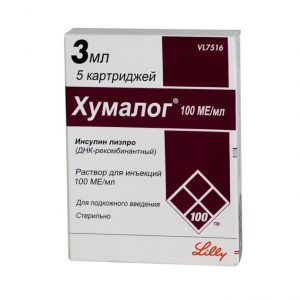Description
Pharmacological action
Hypoglycemic drug for oral administration. Metformin is a biguanide with a hypoglycemic effect, which determines a decrease in the basal (fasting) and postprandial (2 hours after the start of food intake) plasma glucose concentration. Unlike sulfonylurea derivatives, metformin does not stimulate insulin secretion by pancreatic beta cells and does not pose a risk of hypoglycemia.
Increases peripheral receptor sensitivity to insulin and glucose utilization by cells. Reduces liver glucose production by inhibiting gluconeogenesis and glycogenolysis. Delays intestinal absorption of glucose.
Metformin stimulates the synthesis of intracellular glycogen by acting on glycogen synthase. Increases transport capacity of all types of membrane glucose transporters.
Metformin has a beneficial effect on lipid metabolism: it lowers total cholesterol, LDL and triglycerides.
While taking metformin, the patient’s body weight either remains stable or decreases moderately.
Pediatric population
In patients aged 10–16 years who were treated with metformin for 1 year, glycemic control indicators were comparable to those in the adult population.
Pharmacokinetics
Absorption
After oral administration, metformin is absorbed into the digestive tract. Cmax is reached 2.5 hours after ingestion. Bioavailability for dosages of 500 and 850 mg in healthy people is 50-60%. Metformin absorption when administered is saturated and incomplete. Supposed that the pharmacokinetics of absorption of metformin is non-linear. When using metformin in recommended doses and according to the recommended scheme, Css in plasma is reached within 24-48 hours and usually is less than 1 Ојg / ml. C max metformin does not exceed 5 Ојg / ml, even when using the drug in maximum doses.
Eating reduces the degree and slows down the absorption of metformin. After ingestion of an 850 mg tablet, a decrease in C max of 40%, a decrease in AUC of 25% and an increase of 35 minutes in the time to reach C max are observed.
Distribution
Metformin is rapidly distributed in tissues, practically does not bind to plasma proteins. Metformin penetrates red blood cells. C max in the blood is lower than C max in the blood plasma, and is achieved approximately simultaneously. Red blood cells, in all likelihood, represent a secondary distribution depot. The average Vd is in the range of 63-276 liters.
Metabolism
Metformin is excreted unchanged by the kidneys, undergoes very little metabolism, metabolites have not been identified.
Excretion of
After ingestion, 20-30% of the non-absorbed substance is excreted through the intestines. The renal clearance of metformin is more than 400 ml / min, which indicates the elimination of metformin by active glomerular filtration and tubular secretion. After oral administration, T1 / 2 is about 6.5 hours.
In case of impaired renal function, cumulation of the drug is possible, which leads to an increase in the concentration of metformin in blood plasma.
Special patient groups
Patients with impaired renal function. Data available obtained in patients with moderate renal failure, are few and do not allow to reliably assess the systemic effects of metformin in this subgroup, as can be done in individuals with normal renal function.
Pediatric patients. After a single use of metformin at a dose of 500 mg in children, a pharmacokinetic profile was found that was similar to that observed in healthy adults. After repeated use of metformin at a dose of 500 mg 2 times / day for 7 days in children, Cmax and AUC0-t are reduced by approximately 33% and 40%, respectively, compared with the values ​​of these parameters in adult patients with diabetes mellitus treated with metformin dosage of 500 mg 2 times a day for 14 days. Since the dose of the drug is selected individually depending on the level of glycemia, these data are of limited clinical value.
Indications
Type 2 diabetes mellitus (especially in patients with obesity) with ineffective diet therapy and exercise:
in adults as monotherapy or in combination with other oral hypoglycemic agents or with insulin
in children from 10 years old as monotherapy and in combination with insulin.
Contraindications
Hypersensitivity to metformin or any excipient, diabetic ketoacidosis, diabetic precoma,
coma, moderate and severe renal failure or impaired renal function (CC <45 ml / min, GFR <45 ml / min / 1.73 m2 of the body surface) acute conditions occurring with risk of developing renal dysfunction: dehydration (with diarrhea, vomiting), fever, severe infectious diseases, shock acute and chronic diseases that can lead to the development of tissue hypoxia (such as acute myocardial infarction, shock, heart failure l with unstable hemodynamic indicators, respiratory failure) lactic acidosis (including a history) extensive surgery and trauma (against which insulin therapy is indicated) impaired liver function chronic alcoholism, acute alcohol intoxication use for less than 48 hours before and within 48 hours after conducting radioisotope or x-ray studies with iv administration of an iodine-containing radiopaque substance adhering to a low-calorie diet (less than 1000 kcal / day) pregnancy. Caution is advised to use the drug in patients older than 60 years who perform heavy physical work, which is associated with an increased risk of developing lactic acidosis in patients with impaired renal function (CC 45-59 mmol / L, GFR 45-59 ml / min /1.73 m2 of body surface) during the period of breastfeeding. Special instructions Lactate acidosis Lactate acidosis is rare but serious (high mortality in the absence of immediate treatment), metabolic complication that may occur as a result of cumulation of metformin. There are reports of cases of lactic acidosis during treatment with metformin in patients with diabetes mellitus and with severe renal failure or acute impairment of renal function. Particular attention should be paid to situations where renal dysfunction may occur, for example, in the case of dehydration (with severe diarrhea or vomiting) or at the beginning of antihypertensive therapy or diuretic therapy (especially loopback), as well as at the beginning of NSAID therapy. In the event of these acute conditions, therapy with Metformin Zentiva should be temporarily discontinued. Other related risk factors, such as decompensated diabetes mellitus, ketosis, prolonged starvation, excessive alcohol consumption, liver failure, and any condition associated with severe hypoxia (for example, heart failure with unstable hemodynamics, respiratory failure, acute myocardial infarction). The risk of developing lactic acidosis should be considered when nonspecific symptoms such as muscle cramps, dyspeptic disorders, abdominal pain, and severe asthenia appear. Patients should be instructed to immediately inform their doctor about the occurrence of these symptoms, especially if the patient previously tolerated metformin therapy well. In this case, therapy with Metformin Zentiva should be discontinued, at least temporarily, until the situation is clarified. The question of resuming therapy must be decided individually, taking into account the benefit / risk ratio, and also taking into account the state of renal function in this patient. Diagnosis: lactate acidosis is characterized by acidotic shortness of breath, abdominal pain, hypothermia followed by coma. Laboratory indicators include: a decrease in blood pH (less than 7.25), a concentration of lactic acid in blood plasma above 5 mmol / l, and an increased anion gap and the ratio of lactate / pyruvate. If metabolic acidosis is suspected, it is necessary to stop taking metformin and immediately hospitalize the patient. Doctors should inform patients about the risk of lactic acidosis and its symptoms. Surgery You should stop taking the drug Metformin Zentiva 48 hours before the planned surgery under anesthesia, spinal or epidural anesthesia. Therapy can be resumed no earlier than 48 hours after surgery or after the restoration of food intake and only with normal renal function. kidney function metformin is excreted by the kidneys, the QC indicator should be monitored before starting therapy and then regularly: at least once a year in patients with normal renal function at least 2-4 times a year in patients with a QC value at the lower limit of normal and in elderly patients age. With CC <45 ml / min (GFR <45 ml / min / 1.73 m2 of body surface), the use of the drug Metformin Zentiva is contraindicated. Deterioration in kidney function in elderly patients is often asymptomatic. Special care should be taken in case of possible impaired renal function in case of dehydration or with the simultaneous use of antihypertensive drugs, diuretics (especially loopbacks) or NSAIDs. In these cases, it is also recommended to check the status of renal function before starting therapy with Metformin Zentiva. Heart failure Patients with heart failure have a higher risk of developing hypoxia and kidney failure. In patients with stable chronic heart failure, the drug Metformin Zentiva can be used subject to regular monitoring of heart function and kidney function. The use of the drug Metformin Zentiva is contraindicated in patients with acute or chronic heart failure with unstable hemodynamics. Reproductive function Metformin did not affect the reproductive function of male or female rats when used in doses up to 600 mg / kg / day, which is about 3 times higher than the maximum recommended daily dose in humans according to comparison based on body surface area. Children and adolescents The diagnosis of type 2 diabetes mellitus must be confirmed before starting treatment with Metformin Zentiva. In controlled clinical trials lasting one year, the effects of metformin on the growth and puberty of children were not found. However, due to the lack of long-term data, it is recommended to carefully monitor the subsequent effect of metformin on these parameters in children taking Metformin Zentiva, especially in children aged 10-12 years. Other Precautions Patients should be on a diet with regular carbohydrate intake throughout the day. Overweight patients should continue to adhere to a low-calorie diet (but not less than 1000 kcal per day). Routine laboratory tests should be performed regularly to monitor diabetes. Metformin does not cause hypoglycemia during monotherapy, however, caution is advised when using it in combination with insulin or other hypoglycemic agents (for example, sulfonylureas, repaglinide). Long-term therapy with metformin is accompanied by a decrease in the concentration of vitamin B12 in blood plasma, which can cause peripheral neuropathy. Regular monitoring of plasma vitamin B12 concentrations is recommended. Effect on the ability to drive vehicles and control mechanisms The use of the drug Metformin Zentiva as monotherapy does not affect the ability to drive vehicles and mechanisms. When combining Metformin Zentiva with other hypoglycemic agents (including sulfonylurea derivatives, insulin, meglitinides), it is necessary to warn patients about the possibility of developing hypoglycemic conditions in which the ability to drive vehicles and engage in other potentially dangerous activities requiring increased attention and rapid psychomotor reactions. Dosage and administration The drug is taken orally. Tablets should be taken whole during or immediately after a meal with a small amount of liquid. The drug Metformin Zentiva should be taken daily, without interruption. If treatment is discontinued, the patient should inform the doctor. Adults Monotherapy and combination therapy combined with other oral hypoglycemic agents The initial dose is usually 500 mg or 850 mg 2-3 times / day after or during meals. A further gradual increase in dose is possible depending on the concentration of glucose in the blood. After 10-15 days of use, the dose must be adjusted taking into account the results of measuring the concentration of glucose in the blood plasma. Slow dose increases can help improve gastrointestinal tolerance. The maintenance dose is usually 1,500–2,000 mg / day. To reduce side effects from the gastrointestinal tract, the daily dose should be divided into 2-3 doses. The maximum dose is 3000 mg / day, divided into 3 doses. Patients taking metformin in doses of 2000-3000 mg / day can be transferred from taking metformin tablets in a dosage of 500 mg to taking metformin tablets in a dosage of 1000 mg. The maximum recommended dose is 3000 mg / day, divided into 3 doses. If you plan to switch from taking another hypoglycemic agent: you must stop taking another drug and start taking Metformin Zentiva in the dose indicated above. Combination with insulin To achieve better blood glucose control, metformin and insulin can be used as a combination therapy. The initial dose of Metformin Zentiva, as a rule, is 500 mg or 850 mg 2-3 times / day, while the dose of insulin is selected on the basis of blood glucose concentrations. Patients with impaired renal function Metformin can be used in patients with impaired renal function of moderate severity (CC 45-59 ml / min, GFR 45-59 ml / min / 1.73 m2 of body surface) only in the absence of other conditions that may increase the risk of lactic acidosis, and under the following conditions of dose adjustment: the initial dose of Metformin Zentiva is 500 mg or 850 mg 1 time / day. The maximum dose is 1000 mg / day, divided into 2 doses. Careful monitoring of renal function is required (every 3-6 months). If CC <45 ml / min or GFR <45 ml / min / 1.73 m2 of the body surface, Metformin Zentiva should be discontinued immediately. Elderly patients Due to a possible impaired renal function, the dose of Metformin Zentiva in elderly patients should be selected under regular monitoring of renal function indicators (determine the concentration of serum creatinine at least 2-4 times a year). Children and adolescents In children aged 10 years and older, the drug Metformin Zentiva can be used either as monotherapy or in combination with insulin. The initial dose, as a rule, is 500 mg or 850 mg 1 time / day after or during meals. After 10-15 days, the dose must be adjusted based on indicators of glucose concentration in the blood. The maximum daily dose is 2000 mg, divided into 2-3 doses. Side effects of When using Metformin, the following side effects may occur, which are divided into organ-system classes according to the MedDRA classification. Determination of the frequency of side effects according to the WHO classification: very often ( 10%) often ( 1% and <10%) infrequently ( 0.1% and <1%) rarely ( 0.01% and <0.1%) very rarely (< 0.01%) the frequency is unknown (according to available data, it is not possible to determine the incidence of a side effect). From the blood and lymphatic system: frequency unknown – hemolytic anemia. From the side of metabolism and nutrition: very rarely – lactate acidosis, decreased absorption of vitamin B12 in patients with megaloblastic anemia, the frequency is unknown – peripheral neuropathy in patients with vitamin B12 deficiency. From the nervous system: often – distortion of taste sensations frequency is unknown – encephalopathy. From the gastrointestinal tract: very often – nausea, vomiting, diarrhea, abdominal pain, loss of appetite. These undesirable effects most often occur during the initiation of therapy and in most cases resolve on their own. To prevent their occurrence, it is recommended to take a daily dose of metformin for 2 or 3 doses during or after a meal. A slow increase in the dose of the drug can help improve gastrointestinal tolerance. From the skin and subcutaneous tissues: very rarely – erythema, skin itching, urticaria, frequency unknown – photosensitivity. From the liver and biliary tract: very rarely – increased activity of hepatic transaminases or hepatitis, disappearing after drug withdrawal. Influence on the results of laboratory and instrumental studies: the frequency is unknown – a decrease in the concentration of TSH in plasma in patients with hypothyroidism, hypomagnesemia against the background of diarrhea. Children and adolescents Published data, data on post-registration use, as well as the results of controlled clinical trials in a limited population of children aged 10-16 years who were treated with metformin for 1 year, show that adverse events in children by nature and severities are similar to those in adult patients. Overdose Symptoms: when used at a dose of 85 g (at 42. 5 times the maximum daily dose) the development of hypoglycemia was not observed. With an overdose of metformin, lactate acidosis may develop. Lactic acidosis is an emergency and requires inpatient treatment. The reason for the development of lactic acidosis can also be the cumulation of the drug due to impaired renal function. The earliest symptoms of lactic acidosis are nausea, vomiting, diarrhea, lowering body temperature, abdominal pain, muscle pain, and there may be rapid breathing, dizziness, impaired consciousness and coma. Against the background of an overdose of metformin, pancreatitis may occur. Treatment: in case of signs of lactic acidosis, treatment with metformin should be stopped immediately, the patient should be hospitalized urgently, determine the concentration of lactic acid in blood plasma and confirm the diagnosis. The most effective procedure for removing lactic acid and metformin from the body is hemodialysis. Symptomatic treatment is also carried out. Active ingredient Metformin Terms of delivery from pharmacies Prescription Dosage form tablet




